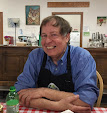COFFEESHOP IS PART OF LEGACY OF JANE ADDAMS
COFFEESHOP IS KEY PART OF
LEGACY OF JANE ADDAMS
BILL'S Coffeeshop customers are often surprised to learn that Jane
Addams imagined places like a coffeeshop as social work settings.
Actually, it was one of earliest innovations introduced by her -- and the
other women of Hull House.
The settlement house opened its doors on Halsted Street in Chicago
in 1889. The coffeehouse opened shortly after that. It was to be a
community gathering place, Addams said, where all would be welcome. The
coffeehouse was both an informal drop-in place as well as the sponsor of a
host of programs, including theater, music, lectures and debates.
By 1895, the coffeehouse experience was in print. It was included
in one of the chapters which make up Hull House Maps and Papers. In 1910,
Addams included the coffeehouse in her best-known book, Twenty
Years at Hull House..
The coffeehouse idea was just one of a host of remarkable ideas
from Addams and the women of Hull House. They also started a day care
center for working mothers, a health clinic, a branch library and a public
playground. All of these were innovations when they began a century ago --
new institutions which responded to specific community needs.
Addams and the women of Hull House were also involved in forming a
host of community organizations. Among the best-known: NAACP, NASW, PTA,
AAUW, American Civil Liberties Union and the Women's International League
for Peace and Freedom. They also helped organize labor unions and
cooperatives.
RESEARCH IS PART OF THE
LEGACY OF ADDAMS, TOO
Little-known today is that all this activity was supported by an
extraordinary amount of research. From the earliest days of Hull House,
Addams and her colleagues were conducting research. Their first book,
Hull House Maps and Papers, is a detailed study of their neighborhood
including both quantitative and qualitative research. There were many
other published studies by Addams and her sister social researchers, from
Safeguards for City Youths (1914) to Tenements of Chicago (1936).
All of this "left a legacy that formed a basis for sociology as a way of
thinking, an area of study and a methodological approach to data
collecting," writes Lawrence Neuman in a new edition of a textbook called
Social Research methods published last year.
But Neuman's acknowledgement of the legacy of research by Addams
and the other women of Hull House is still one of the few one will find in academic
circles. Whether one looks in social work, sociology or urban studies, one
will find little about these feminist scholars.
David Sibley confirms this in an academic essay: "Virtually all texts
in urban geography and urban sociology...present the same history of the
subject. In this conventional account, urban studies began in Chicago in the
school of sociology about 1910...In fact, there were other authors...
analyzing urban problems at the same time and in the same place...
These largely forgotten authors were nearly all women."
SEXISM HAS KEPT THIS LEGACY
OUT OF HIGHER EDUCATION
Why haven't Addams and other women scholars of Hull House
received credit for their research? Blatant sexism is the most important
factor, according to a number of writers.
Mary Jo Deegan reaches this conclusion in her book called Jane
Addams and the Men of the Chicago School. "Despite her [Addams] vision and
contributions...her authorship..has been obliterated from the annals of
the discipline and many of her ideas were only selectively used and
distorted."
David Sibley agrees, offering two quotes from male social
scientists to illustrate their sexists attitudes. One referred to the
women of Hull House as "the old maids downtown who were wet-nursing social
reformers." A second claimed that "the greatest damage done to the city of
Chicago was not the product of corrupt politicians or criminals but the
women reformers."
Neuman, writing in the research text, says Addams was the target
of gender bias on the part of higher education and as a result was "unable
to secure regular work in universities."


0 Comments:
Post a Comment
<< Home